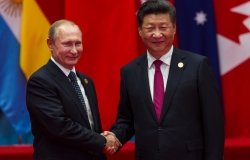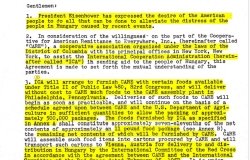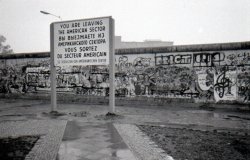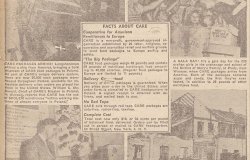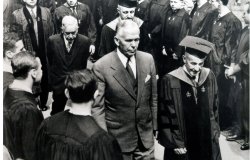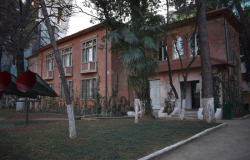Why Did Russia Give Away Crimea Sixty Years Ago?


CWIHP e-Dossier No. 47
The Transfer of Crimea from Soviet Russia to Soviet Ukraine, 1954
Mark Kramer
Crimea was part of Russia from 1783, when the Tsarist Empire annexed it a decade after defeating Ottoman forces in the Battle of Kozludzha, until 1954, when the Soviet government transferred Crimea from the Russian Soviet Federation of Socialist Republics (RSFSR) to the Ukrainian Soviet Socialist Republic (UkrSSR). The transfer was announced in the Soviet press in late February 1954, eight days after the Presidium of the USSR Supreme Soviet adopted a resolution authorizing the move on 19 February. The text of the resolution and some anodyne excerpts from the proceedings of the Presidium of the USSR Supreme Soviet meeting on 19 February were published along with the very brief announcement.[1] Nothing else about the transfer was disclosed at the time, and no further information was made available during the remainder of the Soviet era.
Not until 1992, just after the Soviet Union was dissolved, did additional material about this episode emerge. A historical-archival journal, Istoricheskii arkhiv (Historical Archive), which had been published in the USSR from 1955 until 1962, began appearing again in 1992 with transcriptions of declassified documents from the former Soviet archives. The first issue of the revived Istoricheskii arkhiv in 1992 contained a section about the transfer of Crimea that featured documents from the Russian Presidential Archive and from a few other archives whose collections are now housed at the State Archive of the Russian Federation (GARF). Unfortunately, these documents do not add anything of substance to what was published in the Soviet press 38 years earlier; indeed, they are mostly identical to what was published in 1954. (Apparently, the editors of Istoricheskii arkhiv were unaware that the scripted proceedings of the USSR Supreme Soviet Presidium meeting had already been published in 1954.) The documents do confirm that the move was originally approved by the Presidium of the Communist Party of the Soviet Union (CPSU) on 25 January 1954, paving the way for the authorizing resolution of the Presidium of the USSR Supreme Soviet three weeks later. But the declassified files reveal nothing more about the motives for the transfer, leaving us with just the two official rationales that were published in 1954:
(2) the transfer was a natural outgrowth of the “territorial proximity of Crimea to Ukraine, the commonalities of their economies, and the close agricultural and cultural ties between the Crimean oblast and the UkrSSS.”
Neither of these ostensible justifications holds up to scrutiny. Even though 1954 was the 300th anniversary of the Treaty of Pereyaslav, there is no connection between that treaty and the Crimean peninsula. Pereyaslav, in central Ukraine not far from Kyiv, is nowhere near Crimea, and the treaty had nothing to do with the peninsula, which did not come under Russian control until 130 years later. Moreover, the description of the treaty as having produced the “unification of Russia and Ukraine” is hyperbolic. The treaty did provide an important step in that direction, but years of further struggling and warfare had to take place before full unification occurred. In retrospect the Treaty of Pereyaslav is often associated (inaccurately) with Russian-Ukrainian unity, but it is hard to see why anyone in the USSR would have proposed celebrating the 300th anniversary of the document by transferring Crimea from the RSFSR to the UkrSSR.
The notion that the transfer was justified solely by Crimea’s cultural and economic affinities with Ukraine is also far-fetched. In the 1950s, the population of Crimea — approximately 1.1 million — was roughly 75 percent ethnic Russian and 25 percent Ukrainian. A sizable population of Tatars had lived in Crimea for centuries until May 1944, when they were deported en masse by the Stalinist regime to barren sites in Central Asia, where they were compelled to live for more than four decades and were prohibited from returning to their homeland. Stalin also forcibly deported smaller populations of Armenians, Bulgarians, and Greeks from Crimea, completing the ethnic cleansing of the peninsula. Hence, in 1954, Crimea was more “Russian” than it had been for centuries. Although Crimea is briefly contiguous with southern Ukraine via the Isthmus of Perekop, the large eastern Kerch region of Crimea is very close to Russia. The peninsula did have important economic and infrastructural ties with Ukraine, but cultural ties were much stronger overall with Russia than with Ukraine, and Crimea was the site of major military bases from Tsarist times on, having become a symbol of Imperial Russian military power against the Ottoman Turks.
Even though the publicly enunciated rationales for the transfer of Crimea to the UkrSSR were of little credibility, some of the comments published in 1954 and other information that has come to light since then do allow us to gauge why the Soviet authorities decided on this action. Of particular importance were the role of Nikita Khrushchev, the recent traumas inflicted on Ukraine, and the ongoing power struggle in the USSR.
Khrushchev had been elevated to the post of CPSU First Secretary in September 1953 but was still consolidating his leading position in early 1954. He had earlier served as the head of the Communist Party of Ukraine from the late 1930s through the end of 1949 (apart from a year-and-a-half during World War II when he was assigned as a political commissar to the front). During the last several years of Khrushchev’s tenure in the UkrSSR, he had overseen the Soviet government’s side of a fierce civil war in the newly annexed western regions of Ukraine, especially Volynia and Galicia. The civil war was marked by high levels of casualties and gruesome atrocities on both sides. Despite Khrushchev’s later role in denouncing Stalinism and implementing reforms in the USSR, he had relied on ruthless, unstinting violence to establish and enforce Soviet control over western Ukraine. Occasional armed clashes were still occurring in the mid-1950s, but the war was over by the time Crimea was transferred in February 1954. The repeated references at the meeting of the USSR Supreme Soviet Presidium on 19 February to the “unity of Russians and Ukrainians” and to the “great and indissoluble friendship” between the two peoples, and the affirmation that the transfer would demonstrate how wise it was to have Ukraine “under the leadership of the Communist Party and the Soviet government,” indicate that Khrushchev saw the transfer as a way of fortifying and perpetuating Soviet control over Ukraine now that the civil war had finally been won. Some 860,000 ethnic Russians would be joining the already large Russian minority in Ukraine.
A somewhat similar approach was used in the three newly annexed Baltic republics, especially Latvia and Estonia, both of which had had very few Russian inhabitants prior to the 1940s. The Stalinist regime encouraged ethnic Russians to settle in those republics from the late 1940s on, and this policy continued under Khrushchev and Leonid Brezhnev. Proportionally, the transfer of Russians to the Baltic republics was greater than in Ukraine, but in absolute numbers the transfer of Crimea brought into Ukraine much larger numbers of Russians and a region closely identified with Russia, bolstering Soviet control.
The transfer of Crimea to the UkrSSR also was politically useful for Khrushchev as he sought to firm up the support he needed in his ongoing power struggle with Soviet Prime Minister Georgii Malenkov, who had initially emerged as the preeminent leader in the USSR in 1953 after Joseph Stalin’s death. Having been at a disadvantage right after Stalin’s death, Khrushchev had steadily whittled away at Malenkov’s position and had gained a major edge with his elevation to the post of CPSU First Secretary in September 1953. Nevertheless, the post-Stalin power struggle was by no means over in early 1954, and Khrushchev was trying to line up as much support as he could on the CPSU Presidium for a bid to remove Malenkov from the prime minister’s spot (a feat he accomplished in January 1955). Among those whose support Khrushchev was hoping to enlist was Oleksiy Kyrychenko, who had become first secretary of the Communist Party of Ukraine in early June 1953 (displacing Leonid Mel’nykov, who had succeeded Khrushchev in that post in December 1949) and soon thereafter had been appointed a full member of the CPSU Presidium. In 1944, when Khrushchev himself was still the Communist Party leader in Ukraine, he reportedly had suggested to Stalin that transferring Crimea to the UkrSSR would be a useful way of winning support from local Ukrainian elites.[2] Regardless of whether Khrushchev actually did bring up this matter with Stalin (the veracity of the secondhand retrospective account is uncertain), it most likely reflects Khrushchev’s own sense as early as 1944 that expanding Ukraine’s territory was a way of gaining elite support in the republic. In particular, Khrushchev almost certainly regarded the transfer of Crimea as a means of securing Kyrychenko’s backing. Khrushchev knew that he could not automatically count on Kyrychenko’s support because the two of them had been sharply at odds as recently as June 1953, when Kyrychenko endorsed Lavrentii Beria’s strong criticism of the situation in western Ukraine — criticism that implicitly attacked a good deal of what Khrushchev had done when he was the leader of the republic in the 1940s. Khrushchev hoped that the transfer of Crimea to Ukraine would dispel the lingering tensions from this episode and thereby help to solidify Kyrychenko’s support in the forthcoming showdown with Malenkov.
The earlier published documents, and materials that have emerged more recently, make clear that the transfer of Crimea from the RSFSR to the UkrSSR was carried out in accordance with the 1936 Soviet constitution, which in Article 18 stipulated that “the territory of a Union Republic may not be altered without its consent.” The proceedings of the USSR Supreme Soviet Presidium meeting indicate that both the RSFSR and the UkrSSR had given their consent via their republic parliaments. One of the officials present at the 19 February session, Otto Kuusinen, even boasted that “only in our country [the USSR] is it possible that issues of the utmost importance such as the territorial transfer of individual oblasts to a particular republic can be decided without any difficulties.” One might argue that the process in 1954 would have been a lot better if it had been complicated and difficult, but no matter how one judges the expeditiousness of the territorial reconfiguration, the main point to stress here is that it is incorrect to say (as some Russian commentators and government officials recently have) that Crimea was transferred unconstitutionally or illegally. The legal system in the Soviet Union was mostly a fiction, but the transfer did occur in accordance with the rules in effect at the time. Moreover, regardless of how the transfer was carried out, the Russian Federation expressly accepted Ukraine’s 1991 borders both in the December 1991 Belovezhskaya Pushcha accords (the agreements that precipitated and codified the dissolution of the Soviet Union) and in the December 1994 Budapest Memorandum that finalized Ukraine’s status as a non-nuclear weapons state.
Crimea had originally been an “autonomous republic” (avtonomnaya respublika) in the RSFSR, but its status was changed to that of an “oblast’” (province) in the RSFSR in 1945, ostensibly because the forced removal of the Crimean Tatars had eliminated the need for autonomy. After the Crimean oblast was transferred to the UkSSR in 1954, it retained the status of an oblast’ within Soviet Ukraine for 37 years. In early 1991, after a referendum was held in the UkrSSR and a resolution was adopted a month later by the UkrSSR parliament, the status of Crimea was upgraded to that of an “autonomous republic.” Crimea retained that designation within Ukraine after the Soviet Union broke apart. In the Russian Federation, however, the category of “autonomous republic” does not exist. In the treaty of annexation signed by the Russian and Crimean governments on 18 March 2014, the status of the peninsula was changed to simply a “republic” (Respublika Krym), joining 21 other “republics” of the Russian Federation’s now-85 federal “subjects,” with Crimea and the city of Sevastopol added as separate entities.[[3]
One of the ironies of the transfer of Crimea to Ukraine in 1954 is that when the chairman of the Presidium of the USSR Supreme Soviet, Kliment Voroshilov, offered his closing remarks at the session on 19 February 1954, he declared that “enemies of Russia” had “repeatedly tried to take the Crimean peninsula from Russia and use it to steal and ravage Russian lands.” He praised the “joint battles” waged by “the Russian and Ukrainian peoples” as they inflicted a “severe rebuff against the insolent usurpers.” Voroshilov’s characterization of Russia’s past “enemies” seems eerily appropriate today in describing Russia’s own actions vis-à-vis Ukraine. A further tragic irony of the Crimean transfer is that an action of sixty years ago, taken by Moscow to strengthen its control over Ukraine, has come back to haunt Ukraine today.
Mark Kramer is Director of the Cold War Studies Program at Harvard University and a Senior Fellow of Harvard's Davis Center for Russian and Eurasian Studies
Documents
Document 1
5 February 1954
Decree of the Russian Soviet Federative Socialist Republic Council of Ministers, "Concerning the Transfer of the Crimean Oblast' from the RSFSR to the UkSSR"
TsGA RSFSR [GARF]. F.259. Op.1. D.645. L.159. Published in "Istoricheskii arkhiv" (1992). Translated for CWIHP by Gary Goldberg.
Document 2
5 February 1954
Minutes Nº 41 of a Meeting of the Presidium of the Russian Soviet Federative Socialist Republic [RSFSR] Supreme Soviet
TsGA RSFSR [GARF]. F. 385, Op. 13. D. 492. L. 1-2. Published in "Istoricheskii arkhiv" (1992). Translated for CWIHP by Gary Goldberg.
Document 3
13 February 1954
Decree of the Presidium of the Ukrainian Supreme Soviet, "Concerning the Submission of the RSFSR Supreme Soviet Presidium Concerning the Issue of the Transfer of the Crimean Oblast to the Ukrainian SSR"
GARF. F. 7523. Op. 85. D. 94. L. 8. Published in "Istoricheskii arkhiv" (1992). Translated for CWIHP by Gary Goldberg.
Document 4
15 February 1954
Letter from D. S. Korotchenko and V. Ye. Nizhnik to K. Ye. Voroshilov, with a Report about the Decree of the Presidium of the Ukrainian SSR Supreme Soviet
GARF. F. 7523. Op. 85. D. 94. L. 8. Published in "Istoricheskii arkhiv" (1992). Translated for CWIHP by Gary Goldberg.
Document 5
19 February 1954
Meeting of the Presidium of the Supreme Soviet of the Union of Soviet Socialist Republics
GARF. F.7523. Op.57. D.963, L1-10. Published in "Istoricheskii arkhiv," issue 1, vol. 1 (1992). Translated for CWIHP by Gary Goldberg.
Document 6
Sergey Khrushcehv, Excerpt from Nikita Khrushchev: Reformator (Moscow: Vremya, 2010)
Translated by Anna Melyakova for the National Security Archive.
[1] “V Prezidiume Verkhovnogo soveta RSFSR i Sovete Ministrov RSFSR,” Izvestiya (Moscow), 27 February 1954, p. 1; “V Prezidiume Verkhovnogo Soveta SSSR,” Izvestiya (Moscow), 27 February 1954, p. 2; “Rech’ tovarishcha Tarasova M. P.,” Izvestiya (Moscow), 27 February 1954, p. 2; “Rech’ tovarishcha Korotchenko, D. S.,” Izvestiya (Moscow), 27 February 1954, p. 2; “Rech’ tovarishcha Shvernika N. M.” Izvestiya (Moscow), 27 February 1954, p. 2; “Rech’ tovarishcha Rashidova Sh.,” Izvestiya (Moscow), 27 February 1954, p. 2; “Rech’ tovarishcha Kuusinena O. V.,” Izvestiya (Moscow), 27 February 1954, p. 2; and “Rech’ tovarishcha Voroshilova K. E.,” Izvestiya (Moscow), 27 February 1954, p. 2.
[2] This matter is reported in P. Knyshevskii, “Shtrikhi k portretu kremlevskoi galerei,” Novoe vremya (Moscow), No. 9 (April 1994), p. 54. Knyshevskii claims that Khrushchev told him in 1944 (fifty years earlier) about having raised this matter with Stalin when Khrushchev was visiting Moscow. William Taubman accepts Knyshevskii’s account at face value in Khrushchev: The Man and His Era (New York: W. W. Norton, 2002), p. 163. I am far more skeptical (partly because Khrushchev was well aware of how savagely Stalin had attacked Ukrainian national elites throughout the 1930s, partly because Khrushchev’s main priority in 1944 was to crush the armed insurgency in western Ukraine, and partly because a secondhand account told so long after the fact is inherently difficult to assess), but I do regard it as a plausible reflection of Khrushchev’s own sentiment at the time.
[3] “Dogovor mezhdu Rossiiskoi Federatsiei i Respublikoi Krym o prinyatii v Rossiiskuyu Federatsiyu Respubliku Krym i obrazovanii v sostave Rossiiskoi Federatsii novykh sub”ektov,” 18 March 2014, signed in Moscow.
About the Author

Mark Kramer
Mark Kramer is Director of Cold War Studies at Harvard University and a Senior Fellow of Harvard's Davis Center for Russian and Eurasian Studies.
Read More
Cold War International History Project
The Cold War International History Project supports the full and prompt release of historical materials by governments on all sides of the Cold War. Through an award winning Digital Archive, the Project allows scholars, journalists, students, and the interested public to reassess the Cold War and its many contemporary legacies. It is part of the Wilson Center's History and Public Policy Program. Read more

History and Public Policy Program
The History and Public Policy Program makes public the primary source record of 20th and 21st century international history from repositories around the world, facilitates scholarship based on those records, and uses these materials to provide context for classroom, public, and policy debates on global affairs. Read more
